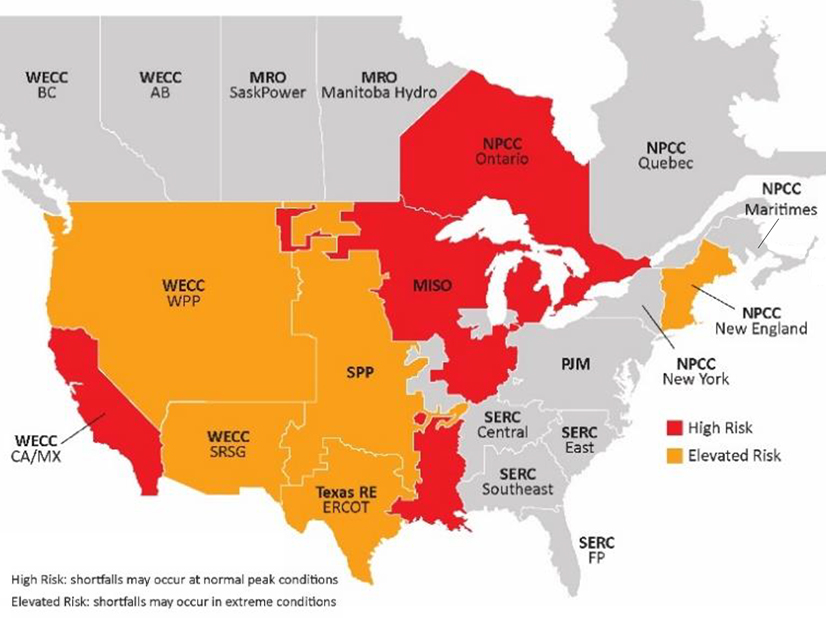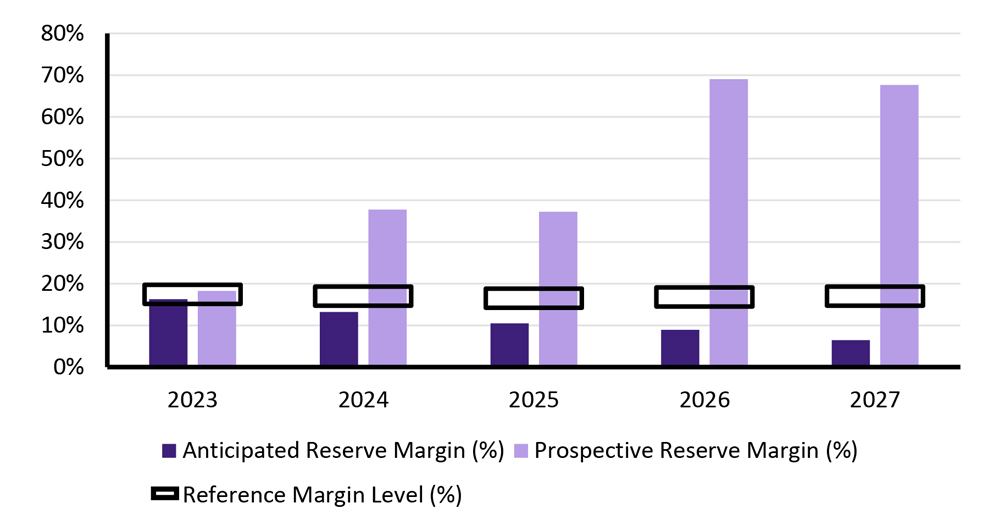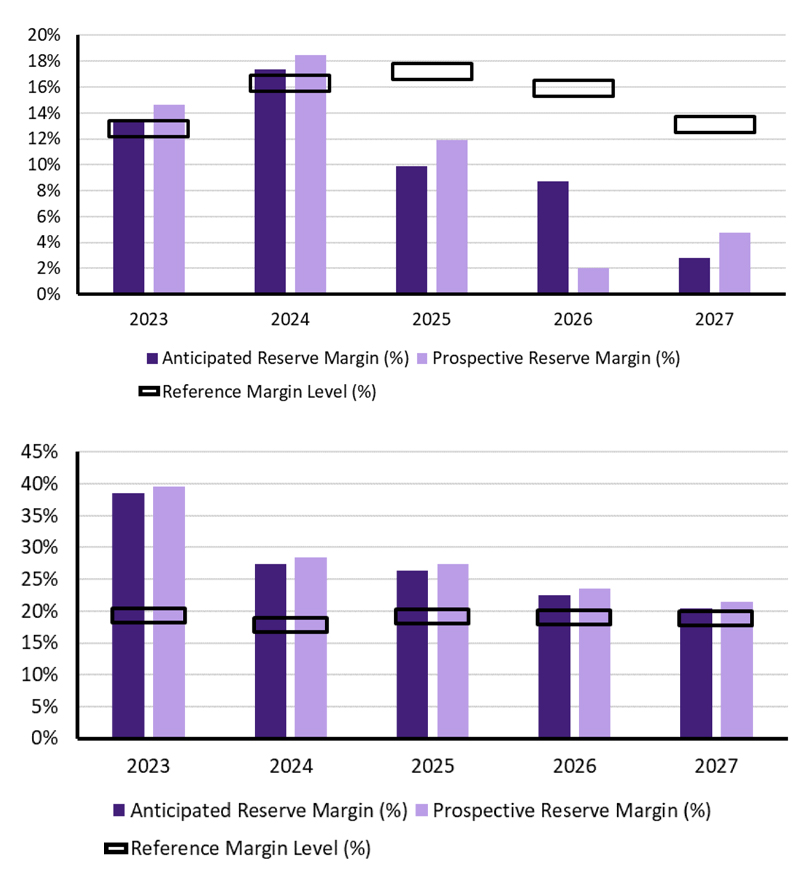
The coming decade will be marked by “extraordinary reliability challenges and opportunities” amid rapid changes in the climate and the North American electric grid, NERC staff said while introducing the organization’s Long-Term Reliability Assessment (LTRA) on Thursday.
“Year after year, we’ve seen extreme weather leading to increased reliability events. … It’s clear that the bulk power system is impacted by extreme weather more than it ever has,” John Moura, NERC’s director of reliability assessment and performance analysis, said at a media event accompanying the report’s release. “So, as we transition our system so rapidly, it’s vitally important that we’re planning and operating a [BPS] that can be resilient to the extreme weather we’re seeing.”
NERC produces the LTRA every year in coordination with the regional entities to assess North American resource adequacy and identify trends, emerging, issues and potential risks during the coming 10 years. This year’s report found most of the continent as either high-risk — meaning energy shortfalls may occur at normal peak conditions in one or more years — or elevated, in which case reserves meet normal resource adequacy criteria but severe heat or cold could lead to shortfalls.
MISO, Ontario at High Risk
MISO and NPCC-Ontario led the high-risk areas, with projected shortfalls for each region exceeding 1,000 MW. Most urgent is the 1,300 MW in MISO, where NERC now expects the reserve margin to fall below the reference margin level beginning next year — a year earlier than the prediction from last year’s LTRA. Mark Olson, NERC’s manager of reliability assessments, explained in Thursday’s call that generation retirements in MISO are “outpacing the new resource additions, and not keeping up with resource adequacy criteria.”
Shortfalls are expected to begin in NPCC-Ontario as early as 2025, with the anticipated reserve margin (ARM) dropping below the reference margin level by 1,700 MW in that year and 2026, driven by “planned retirements and lengthy outages for nuclear units undergoing refurbishment.”
 Five-year projected reserves for MISO (left) and NPCC. | NERC
Five-year projected reserves for MISO (left) and NPCC. | NERC
Regarding the nuclear outages, NERC observed that Ontario Power Generation has proposed to extend the operation of Pickering Nuclear Generating Station, which is currently expected to retire in 2025, through September 2026. The LTRA’s ARM for NPCC-Ontario was calculated under the assumption this proposal would be approved by Canada’s Nuclear Safety Commission.
The last high-risk area is California. Although the state now seems set to avoid the shortfall that last year’s LTRA predicted would begin in 2026, thanks to added capacity, NERC noted it “remains dependent on electricity imports to manage periods of extreme electricity demand or low resource output.” A probability assessment for 2024 showed that while most months show a low risk of load loss and unserved energy in the state, August and September had high risks of more than two hours of load loss due to warm temperatures and “potentially volatile electricity demand.”
Olson said California’s Diablo Canyon nuclear plant was not included in the LTRA due to uncertainty around its continued operation, but that it “would certainly help alleviate risk.” The 2.2 GW plant was scheduled to close by 2025, but the state this year determined that its baseline contribution was essential for reliability, and the Department of Energy last month awarded PG&E $1.1 billion to help keep it in operation. (See DOE Grants PG&E $1B for Diablo Canyon Extension.)
Variable Generation a Continuing Concern
Areas at elevated risk include the U.S. Northwest and Southwest, SPP, Texas and New England. In those regions, capacity should be sufficient to meet normal peak demand; however, conditions under NERC’s 90/10 forecast — which has a 10% chance of being exceeded — could lead to outages.
 Tier 1 and 2 planned resources projected through 2032. | NERC
Tier 1 and 2 planned resources projected through 2032. | NERCFor Texas, the report noted that “ERCOT’s winter peak load varies substantially … between the coldest temperatures of an average year and a more extreme year.” Although changes by state regulators, ERCOT and generator owners since the winter storm of February 2021 should reduce the risk of disruption, NERC said the state still has cause for concern.
The biggest risk for New England continues to be dependence on natural gas for electricity and the risk of gas supply bottlenecks due to increased heating demand in severe cold. The report reminded readers that stored backup fuels are “critical” to ensuring grid reliability.
WECC and SPP face risks due to high demand and variable output, highlighting an ongoing issue in the BPS. As in previous years, projections for planned resources for the next decade show that wind, solar and gas “are the overwhelmingly predominant generation types in the planning horizon.”
Michelle Bloodworth, CEO of coal industry advocate America’s Power, said in a press release that the increasing presence of weather-dependent resources in the electric grid is worrying. She called for utilities not to abandon conventional generation sources without a better understanding of how to maintain reliability.
“We remain deeply concerned that the grid is being forced to rely on less dependable electricity sources in the future because of coal retirements. We strongly urge the Federal Energy Regulatory Commission and grid operators to act as quickly as possible to value all reliability attributes,” Bloodworth said. “In addition, we urge utility commissioners to pause coal retirements until grid operators have identified and valued all reliability attributes.”

